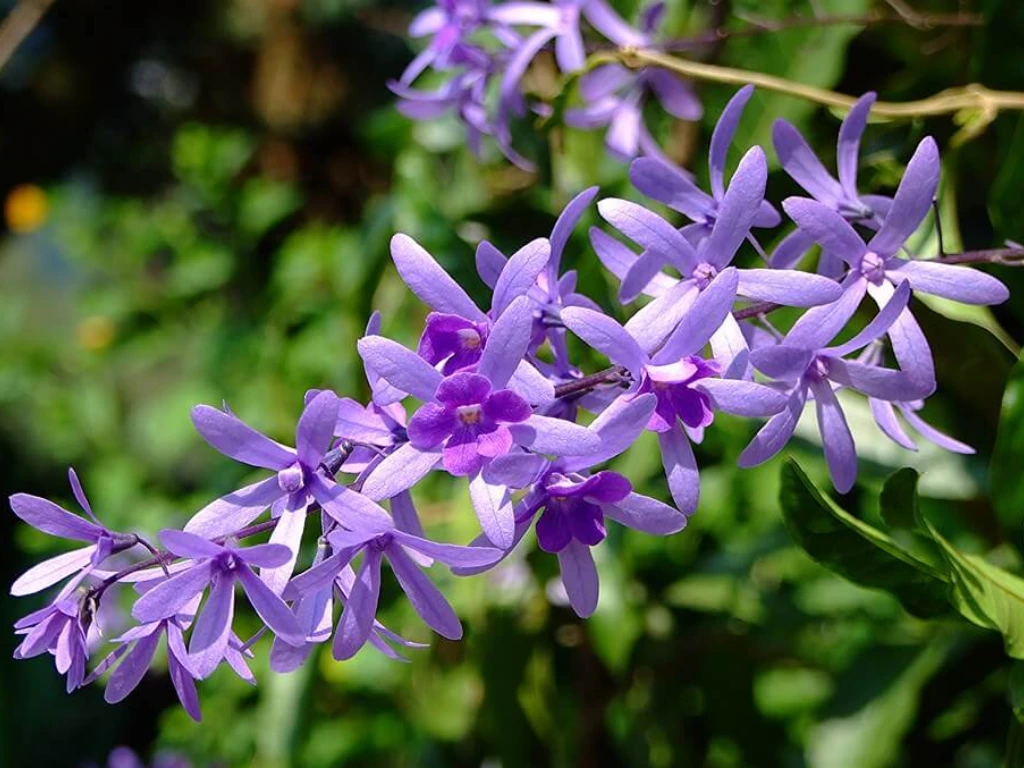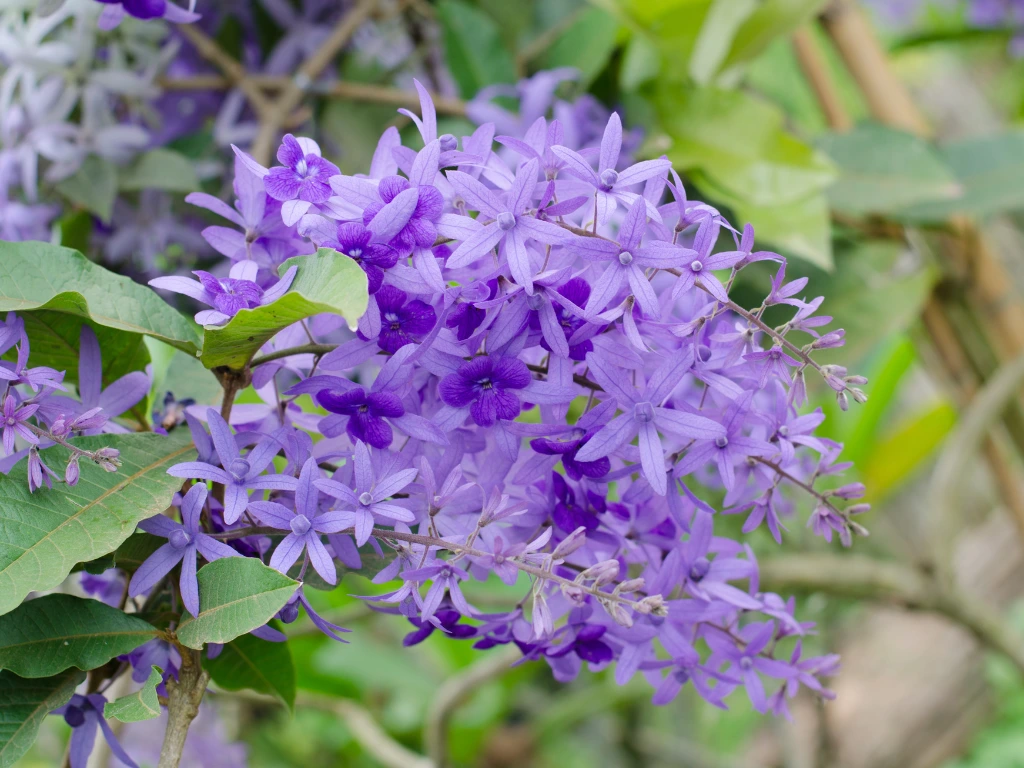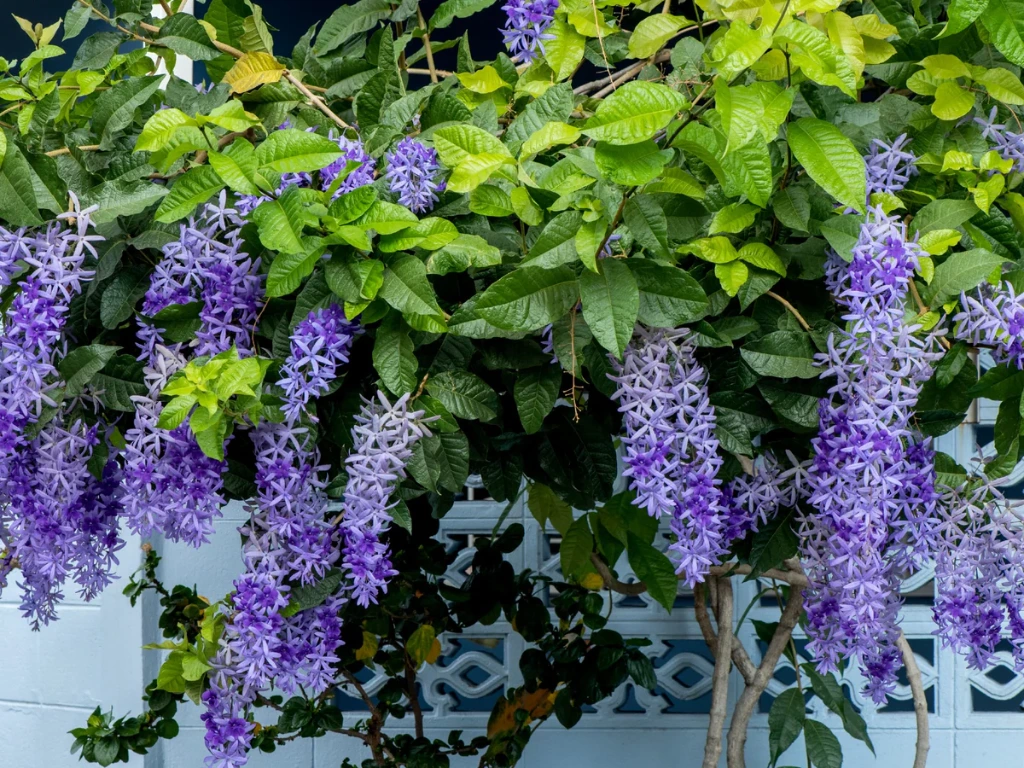Guides
How to Grow and Care for Queen’s Wreath Vine: A Complete Guide
Have you ever dreamed of a garden overflowing with vibrant, purple blooms that cascade down from a trellis or fence? If so, the Queen’s Wreath Vine (Petrea volubilis) might just be the perfect addition to your outdoor space. Known for its stunning, purple flower clusters, this tropical flowering vine can thrive in the right conditions and bring your garden to life. But how do you properly care for and grow Queen’s Wreath Vine? In this article, I’ll walk you through everything you need to know to get started.
Whether you’re new to gardening or an experienced green thumb, this guide will help you ensure your Queen’s Wreath Vine flourishes year after year. Let’s dive in!
What is Queen’s Wreath Vine?

Native to tropical regions of Central and South America, Petrea volubilis, or Queen’s Wreath Vine, is well-loved for its striking purple flowers that resemble clusters of orchids. This vine is sometimes referred to as the “sandpaper vine” because of its coarse-textured leaves, which are a distinctive feature.
Why grow Queen’s Wreath Vine?
-
Beauty: Its cascading clusters of purple flowers make it an eye-catching addition to any garden.
-
Attracts wildlife: The bright blooms attract butterflies and bees, making it an excellent choice for pollinators.
-
Low-maintenance: Once established, Queen’s Wreath Vine is relatively easy to care for, provided it gets the right environment.
Growing Conditions for Queen’s Wreath Vine
The first step in ensuring your Queen’s Wreath Vine grows well is understanding the ideal growing conditions. Whether you’re planting it as a climbing vine for a trellis or a beautiful addition to your garden, these factors will make or break your vine’s success.
1. Light Requirements
Queen’s Wreath Vine loves full sun and thrives best when it receives at least 6 hours of direct sunlight daily. While it can tolerate partial shade, you’ll likely see fewer blooms if it doesn’t get enough sunlight.
2. Soil Preferences
Like most tropical plants, Queen’s Wreath Vine prefers well-draining soil. It doesn’t like to sit in waterlogged soil, so ensure that your garden bed or container has good drainage. A slightly acidic to neutral pH (6.0 to 7.0) is ideal.
3. Temperature and Humidity
This tropical plant thrives in warm conditions and requires temperatures above 50°F (10°C). It’s best suited to USDA hardiness zones 9 through 11. If you live in cooler areas, you may want to grow Queen’s Wreath Vine in a container that can be moved indoors during colder months.
How to Plant Queen’s Wreath Vine
Planting Queen’s Wreath Vine is straightforward, but it’s important to get it right to set the foundation for healthy growth. Here’s how to plant this beautiful vine:
1. Choose Your Planting Material
You can grow Queen’s Wreath Vine from cuttings, seeds, or young plants. The fastest way is to buy a young plant from your local nursery or garden center, but if you want to propagate it yourself, cuttings work well.
2. Planting Steps
-
Dig a hole twice the size of the root ball.
-
Place the plant in the hole, ensuring that the top of the root ball is level with the soil surface.
-
Water thoroughly after planting.
-
If planting in a container, choose a pot that is at least 18 inches deep and wide, with proper drainage holes.
Make sure to provide a trellis or support structure for the vine to climb. Queen’s Wreath Vine is a climbing vine, so it will need something to hold onto as it grows upward.
Caring for Queen’s Wreath Vine

Now that your Queen’s Wreath Vine is planted, the real fun begins. Proper care will ensure that your vine thrives and produces those beautiful purple flowers. Let’s take a look at what you need to do:
1. Watering
Queen’s Wreath Vine enjoys moderate watering. Water the plant deeply but allow the soil to dry slightly between waterings. Overwatering can lead to root rot, so always check the soil moisture before adding more water.
2. Fertilizing
Fertilize your Queen’s Wreath Vine with a balanced fertilizer every 4-6 weeks during the growing season (spring through summer). Use a slow-release fertilizer or a liquid fertilizer diluted to half strength. Organic options, like compost or fish emulsion, can also work well.
3. Pruning
Pruning helps to control the size of the vine and encourages more flowers. You should prune your Queen’s Wreath Vine after it blooms. Remove any dead or damaged growth and cut back the vine to maintain its shape. Regular pruning also prevents the plant from becoming too leggy.
Propagating Queen’s Wreath Vine
If you want to grow more Queen’s Wreath Vines or share them with friends, propagation is easy. Here’s how to propagate this vine:
1. Cuttings
To propagate by cuttings, take a healthy 4-6 inch cutting just below a leaf node. Remove the lower leaves, dip the cut end in rooting hormone, and plant it in a pot filled with a well-draining potting mix. Keep the soil moist and the cutting in a warm location. In a few weeks, roots will start to form, and you can transplant the cutting into the garden or a larger container.
2. Air Layering
Another way to propagate Queen’s Wreath Vine is through air layering. Select a healthy vine, make a small incision in the stem, and wrap it with moist sphagnum moss. Once roots develop, you can cut the new plant from the parent vine and transplant it.
Common Issues and How to Solve Them
Like any plant, Queen’s Wreath Vine can encounter a few issues along the way. Here’s a list of common problems and how to address them:
-
Yellowing Leaves: If your vine’s leaves turn yellow, it might be due to overwatering or poor drainage. Check the soil and adjust watering accordingly.
-
Pests: Aphids and spider mites can sometimes attack Queen’s Wreath Vine. Use insecticidal soap or neem oil to treat the infestation.
-
No Blooms: If your Queen’s Wreath Vine isn’t blooming, it might not be getting enough sunlight. Ensure it’s receiving at least 6 hours of sun each day.
Queen’s Wreath Vine in Landscape Design

One of the best things about Queen’s Wreath Vine is how versatile it is in landscaping. Whether you want a climbing vine for a trellis, a gorgeous addition to your garden wall, or a statement piece on a pergola, this vine can do it all.
Design Tips:
-
Plant Queen’s Wreath Vine along fences or trellises to create a stunning floral display.
-
Pair it with other flowering vines like bougainvillea or wisteria for a colorful garden.
-
Use Queen’s Wreath Vine to provide shade or privacy on patios or balconies.
Conclusion
Queen’s Wreath Vine is a magnificent, low-maintenance plant that can brighten up any garden. By providing the right growing conditions, proper care, and occasional pruning, you can enjoy stunning blooms for years to come. Whether you’re in a tropical climate or a cooler area, there are ways to grow this vine and enjoy its beauty successfully.
If you’re looking for a vine that is both eye-catching and easy to grow, give Queen’s Wreath Vine a try. Follow the steps outlined in this guide, and you’ll soon see why so many gardeners in the U.S. love this plant. Ready to transform your garden with this gorgeous vine? Start planting today, and enjoy the stunning purple blooms that will make your garden the talk of the neighborhood!
You may like:


7 Vegetables to Plant in December for a Bountiful Winter Harvest
Winter gardening is a challenge many new gardeners shy away from. But if you’re among [...]
Dec
9 Common Christmas Cactus Problems and How to Fix Them
Have you ever walked past your Christmas cactus and wondered why it suddenly looks sad? [...]
Nov
Swedish Ivy Care: How to Grow a Healthy, Thriving Plant
Have you ever looked at your Swedish Ivy and wondered why the leaves are turning [...]
Nov
Avoid These 10 Garlic Planting Mistakes for Bigger, Healthier Bulbs
Growing garlic at home is one of the most satisfying things a gardener can do [...]
Nov
How to Prevent Christmas Cactus Bud Drop: Tips for a Healthy Bloom
Have you ever noticed your beautiful Christmas cactus (Schlumbergera) starting to lose its buds just [...]
Nov
Discover 7 Stunning Types of Night-Blooming Cereus
Have you ever waited for a flower that only opens at night and then disappears [...]
Nov